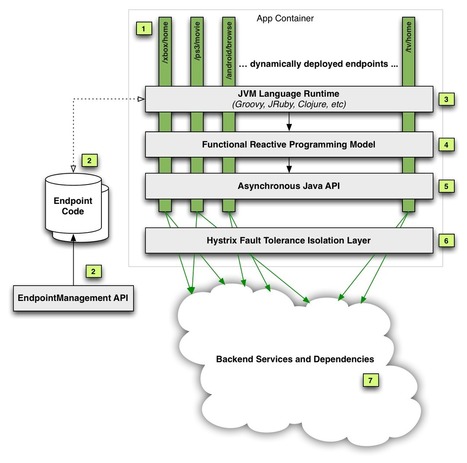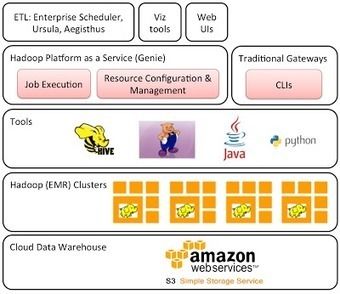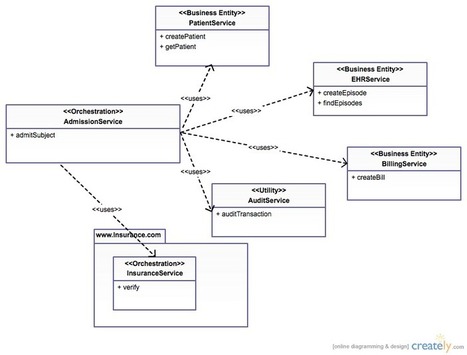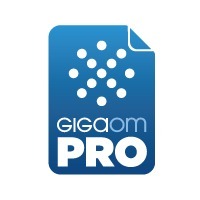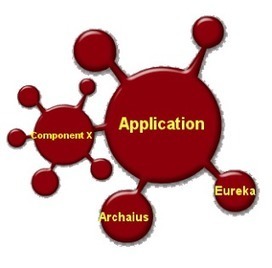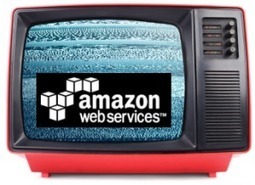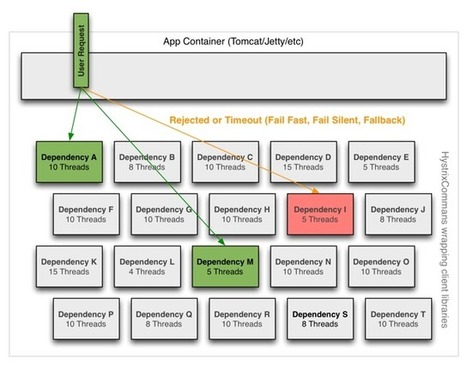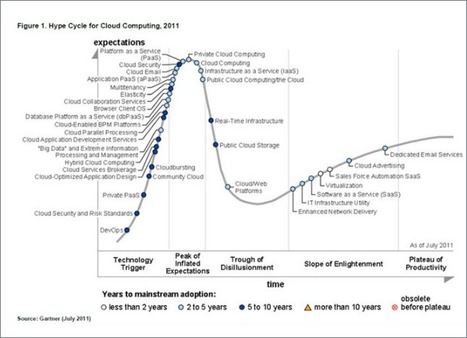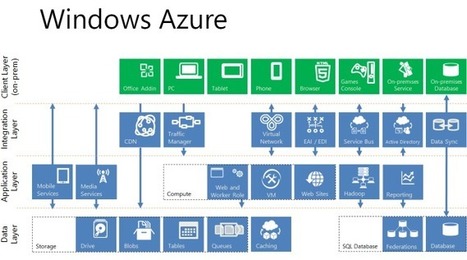 Your new post is loading...
 Your new post is loading...
Cloud computing is no longer a technology on the cusp of breaking out but a valuable and important technology that is fundamentally changing the way we use and develop on-demand applications. As you would expect, Linux and open source provide the foundation for the cloud (for public and private infrastructures). Explore the anatomy of the cloud, its architecture, and the open source technologies used to build these dynamic and scalable computing and storage platforms.
The reign of end-to-end OTT platforms is over, here comes the modular OTT Platform ! With SOA, FIMS, IMF and DASH, agility time has (almost) come... This is the report/sequel of Vimond's Industry Visionaries IBC2013 talk about “The Future of OTT Platforms: Is it Diversification or Standardization ?” with Eric Schumacher-Rasmussen, Editor of Streaming Media Magazine, and Nicolas Weil.
A few years ago I was asked by one of our customers to help them make better use of their integration layer. Ever since then me and my team have been working on a framework in support of that. This is the third in a series of blogs on the development of our framework, and discusses the challenges we had to meet.
As the API movement marches forward, it continues to grind against the enterprise and its legacy of Service Oriented Architecture (SOA), which increases the frequency at which people ask me, What is the difference between API and SOA? This is not a technical explanation of the differences, but a philosophical one that many will argue does not apply, but in my opinion is the dark matter around the technological and business approach of SOA, that makes API work. Many say that a web API is just one component in an SOA toolbox. This is true. Using HTTP for an API is not that novel in itself. That is until it jumped out of the enterprise petri dish, got a little oxygen to grow, allowing the introduction of some new aspects that the industry and technology overlords of SOA would never have introduced on their own.
The Netflix API optimization story is an interesting journey from a generic one-size-fits-all static REST API architecture to a more dynamic architecture that lends power to the client team to define and deploy their custom service endpoints.
Hadoop has become the de facto standard for managing and processing hundreds of terabytes to petabytes of data. At Netflix, our Hadoop-based data warehouse is petabyte-scale, and growing rapidly. However, with the big data explosion in recent times, even this is not very novel anymore. Our architecture, however, is unique as it enables us to build a data warehouse of practically infinite scale in the cloud (both in terms of data and computational power). In this article, we discuss our cloud-based data warehouse, how it is different from a traditional data center-based Hadoop infrastructure, and how we leverage the elasticity of the cloud to build a system that is dynamically scalable. We also introduce Genie, which is our in-house Hadoop Platform as a Service (PaaS) that provides REST-ful APIs for job execution and resource management.
The SOA architecture stipulates the creation of a repository of standardised and reusable services which can be composed or integrated into an aggregate service which automates a business process. The Enterprise Service Bus is an essential component in a SOA and is the ideal hosting environment for Service Orchestration. In this post I’m going to describe service orchestration with a Hospital Admissions Example.
Jointly developed by CompatibleOne and Cedexis, the solution will enable customers to distribute their workloads on distributed and heterogeneous clouds including private, public and community platforms. These workloads will be automatically provisioned and deployed across different providers of cloud resources, depending on customers’ requirements.
As you may recall, Citrix turned the CloudStack open-source cloud project over to the Apache Foundation awhile ago. This week the first Apache-blessed code is out, as reported by GigaOM’s own Barb Darrow. “The new 4.0.0 ‘incubating release’ of CloudStack adds CloudBridge, an Amazon Web Services (AWS) API extension, right into the CloudStack package so that users can ‘turn on’ Amazon S3 and EC2 support if they want.” This means that those committing to CloudStack can also enable AWS compatibility, perhaps hedging your cloud computing bets, or supporting existing AWS-based systems. Amazon API compatibility continues to become more important in the world of public and private IaaS providers. Rackspace lacks AWS compatibility with its OpenStack cloud, however, guys like Cloudscaling consider their AWS compatibility a selling point.
Originally used as an inexpensive alternative to quickly deploy services outside the realm of IT, cloud computing is quickly becoming a de facto standard for new application resources. The challenge is how to manage those resources transparently. The cloud should be an extension of the internal data center, and cloud bridges, gateways and brokers are all components that IT should focus on for connecting to their external cloud deployment. But there are challenges to integrating bridges, gateways and brokers to any production cloud deployment. First, the market is still shaking out what each of these product categories do and what they're called. Second is where they fit in the infrastructure, and then third and possibly most important, who owns these technologies and who ultimately is responsible for their success. If addressed early and architected correctly, however, cloud bridges, gateways and brokers can add value to the cloud.
Cedexis OpenMix - a flexible SaaS Load Balancing service – is now available via the AWS Marketplace. Two offerings are now available, as detailed below, each of which can incorporate real-time Cedexis Radar data to improve the Availability and/or Performance of your Web Sites or Web Applications : - Multiple AWS Region Load Balancing - Private Datacenter to AWS Region Load Balancing
In a new post, Chris Bruzzi and Nick Hamm, both with Appirio, a cloud services provider, share their experiences in cloud application development. They point to the five changes in mindset that needs to take place as application development and deployment evolves to the cloud world : - Architect solutions in a componentized way - Value application programming interfaces (APIs) over language - Drive reuse wherever possible - Extend your team with crowdsourcing - Measure your applications
|
The Netflix API has undergone a transformation since its inception in 2008. It has transitioned from being a public API with a generic RESTful interface to a platform for creating highly optimized, device-centric APIs that are critical to delivering the Netflix streaming experience on over 1000 different device types.
This talk covers the design principles that shaped the transformation of the API as well as the technology that powers it, enabling rapid user experience iteration and bringing Netflix streaming to almost 38 million subscribers around the world.
At Re:Invent, the AWS conference in Vegas last November, Amazon’s CTO, Werner Vogels, made an interesting observation during his keynote address: “An EC2 instance is not a server—it’s a building block.” This sounded suspiciously like a tagline a car manufacturer might use to convince me that their car “isn’t just another car.” But something about Vogels’ statement stuck with me. I had used EC2 since the public beta and he succinctly stated something that I knew to be true but didn’t understand why. It took a few months before I put the pieces together and could articulate what EC2 is and what it is not. From all outward appearances, and even functionally-speaking, an EC2 instance behaves as a virtualized server: A person can SSH (or Remote Desktop) into it and install nearly any application. In fact, from my experience, this is how >95% of developers are using AWS. However, this is a very myopic view of the platform. Most of the complaints levied against AWS (unreliable, costly, difficult to use) are by those who are trying to use EC2 as if it were a traditional server located in a datacenter.
Karyon, in the context of molecular biology is essentially "a part of the cell containing DNA and RNA and responsible for growth and reproduction."
At Netflix, Karyon is a framework and library that essentially contains the blueprint of what it means to implement a cloud ready web service. All the other fine grained web services and applications that form our SOA graph can essentially be thought as being cloned from this basic blueprint.
As Amazon’s Web Services makes its move into the enterprise, one of the biggest obstacles they face will be in the world of security. The stakes are huge in a mission-critical enterprise environment, the elements of risk, security, and compliance have formed a significant barrier to public cloud adoption. Tactical, strategic, and security professionals throughout the industry are finding difficulties in making this switch. At root of these issues is the outright lack of control and visibility into a cloud provider’s infrastructure; a deal-breaker in case after case because of security and compliance concerns. The amount of transparency that Amazon operates with requires a massive leap of faith that the typical enterprise cannot embrace - even legally in some cases. The AWS Risk and Compliance whitepaper frames an arrangement that lays out a “shared responsibility” security structure, in that AWS controls the physical aspects of the technology to the hypervisor, and all layers beyond that are on the customer.
One of the great advantages of moving from a private datacenter into the cloud is that you have quick and easy access to nearly limitless new resources. Innovation and experimentation friction is greatly reduced: to push out a new application release you can quickly build up a new cluster, to get more storage just attach a new volume, to backup your data just make a snapshot, to test out a new idea just create new instances and get to work. The downside of this flexbility is that it is pretty easy to lose track of the cloud resources that are no longer needed or used. Perhaps you forgot to delete the cluster with the previous version of your application, or forgot to destroy the volume when you no longer needed the extra disk. Taking snapshots is great for backups, but do you really need them from 12 months ago? It's not just forgetfulness that can cause problems. API and network errors can cause your request to delete an unused volume to get lost.
At Netflix, when we analyzed our Amazon Web Services (AWS) usage, we found a lot of unused resources and we needed a solution to rectify this problem. Diligent engineers can manualy delete unused resources via Asgard but we needed a way to automatically detect and clean them up. Our solution was Janitor Monkey.
Hystrix: it’s the genus name for “Old World” porcupines, and it’s also the latest release from Netflix. But you won’t see it in their catalog of movie and TV titles, and you can’t add it to your queue, because it’s not content–it’s how Netflix makes sure its content is highly available. Now, Netflix has made Hystrix open source, for anyone using Amazon Web Services (AWS) to implement in their own cloud applications. Read on for details on this “resilience engineering” code library.
Latest version of Netflix Architecture presentation, variants presented several times during October 2012...
A few years ago I was asked by one of our customers to help them make better use of their integration layer. Ever since then me and my team have been working on a framework in support of that. This is the second in a series of blogs on the development of our framework, and discusses the goals we had to reach.
SOA Software has a new management platform that company executives say better addresses the enterprise API market more so than the open API providers whose services have come into vogue in the past few years. The proclamation is a shot across the bow of many an API provider — Apigee, Mashery and Layer 7 Technologies to name a few. According to SOA Vice President of Product Management Ian Goldsmith, Apigee and Mashery represent the “open API,” market that has mushroomed as more apps connect through RESTful APIs. He said their services are not suitable for enterprise APIs, as they don’t offer the end-to-end management that SOA offers. Layer 7, in Goldsmiths’s view, at its core is a run-time security platform that has pivoted to the API management market. I find this characterization by Goldsmith a bit simple. All three of these providers have enjoyed phenomenal growth, as more companies develop apps and use APIs to connect with other apps and services. They all have legions of customers with no end in sight. Apps now come with APIs — it’s almost a prerequisite. Apigee, Mashery and Layer 7 are positioned to suit that market. I don’t want to get into the different attributes of each company in this post. I’ll get to that this weekend. But these are companies that give the customer access to all the modern apps that are defining innovation in today’s enterprise environment. SOA is different. To me, it’s matter of fact if not a bit old school. It may not be sexy, but it gets the job done.
The first version of the CloudStack open-source cloud platform carrying the Apache Foundation imprimatur is now available for download. The new “Incubating release” 4.0.0 integrates CloudBridge Amazon API support and support for Ceph and Caringo storage options.
Are you ready for the figure of cloud computing. This presentation by David Linthicum let you know what is just around the corner.
One of my favorite ways to present an overview of Windows Azure is via the following image. Well, this is really the last image of a typical presentation, since I start with a blank slate and successively add service blocks and a bit of narrative along the way. The image below is interactive, so you can hover over each of the components and click to go to the relevant section of the Windows Azure web site to learn more about the feature.
|



 Your new post is loading...
Your new post is loading...

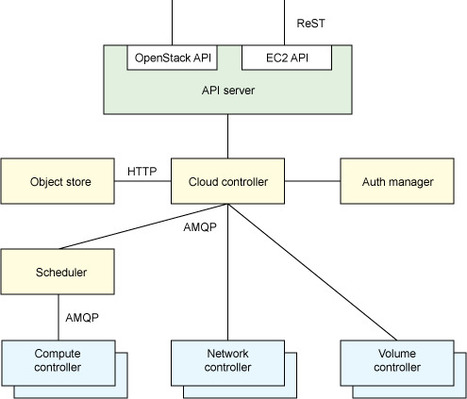

![[IBC 2013 Talk] The Future of OTT Platforms | SOA Breakthroughs | Scoop.it](https://img.scoop.it/QcV918WTWh5B0iROqlVSxDl72eJkfbmt4t8yenImKBVvK0kTmF0xjctABnaLJIm9)


